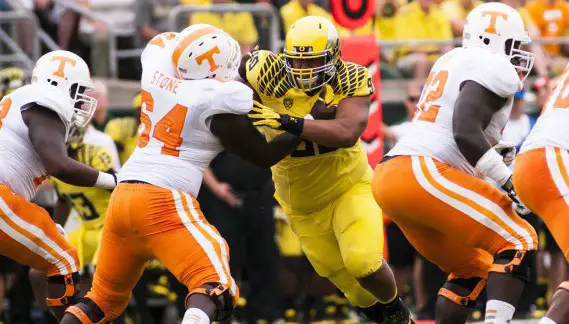The Oregon ‘hybrid’ 3-4 Defense is a well-designed, precision machine — as any well run defense is. Oregon defenders don’t just chase the football around like a rec league soccer game. Every player on the field has a job to do, and all of those jobs fit together like a choreographed dance that will shut down the opponent’s rushing attack — or react accordingly to defend the pass.
In my last article, I talked about the different types of jobs on the defense and these are universal jobs on any team’s ‘spill’ defense, although the terms are certainly not universal (nearly every defense is a spill defense in today’s game). Understanding those roles and teaching them to the players is the critical job of the Defensive Coordinator and his staff. Now, let’s drill down to one specific job more fully, the spill players in the Ducks’ 3-4 Defense.
In Oregon’s scheme, the Defensive Linemen and Inside Linebackers will nearly always be spill players. These are players aligned on the interior of the defense, trying to prevent the ball carrier from running North-South, instead forcing him to continue running laterally toward the sidelines and the ‘force’ players. Additionally, one or both of the Outside Linebackers will be a spill player.
The Outside Linebacker is one of the toughest and most vital positions on the Ducks defense because they can be both spill and force players. Safeties and Corners will also handle the additional force and ‘secondary force’ jobs. The objective of the force players is to turn the ball carrier back inside, to the pursuing spill defenders. Take a look at this short video that explains how our defenders are going to fit an Inside Zone run play … Spill players will always work to fit the inside half of their gap. For the Ducks’ Defensive Linemen, that means reading the initial steps of the blocker they are lined up across from, and fighting to control the gap he steps to. He mirrors the footwork of the blocker and fights to get his hips into the space that the Offensive Lineman is trying to control. As long as the defender has his hips in control of the inside half of his assigned gap, he effectively controls the entire gap and forces the ball carrier to continue running laterally, searching for another opening to dive into. 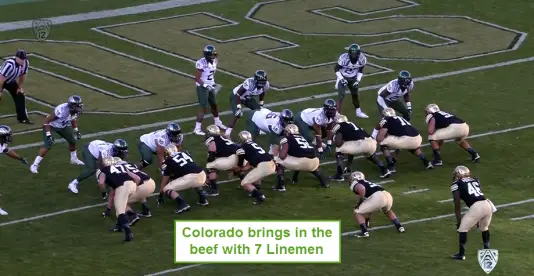 Check out the Ducks tightening up near the goal line against Colorado in the play shown above. The Buffaloes are in an overload formation to the right, with 7 Linemen on the field, but run their “G” Power Play back to the left. The Right Guard pulls to kick out No. 12, Brian Jackson, who is the force player on this particular play. The Fullback is supposed to come tight to the Colorado double team by the Left Tackle and H-Back, and pick up the Inside Linebacker, as you will see below.
Check out the Ducks tightening up near the goal line against Colorado in the play shown above. The Buffaloes are in an overload formation to the right, with 7 Linemen on the field, but run their “G” Power Play back to the left. The Right Guard pulls to kick out No. 12, Brian Jackson, who is the force player on this particular play. The Fullback is supposed to come tight to the Colorado double team by the Left Tackle and H-Back, and pick up the Inside Linebacker, as you will see below.  Instead, the pulling Guard comes too wide and blocks the secondary force defender No. 14, Efo Ekpre-Olomu. The Ducks’ Inside Linebacker, No. 48 Rodney Hardrick, shows a great example below of controlling the inside half of the gap by fitting so tight to the double team that the blocker didn’t even see him.
Instead, the pulling Guard comes too wide and blocks the secondary force defender No. 14, Efo Ekpre-Olomu. The Ducks’ Inside Linebacker, No. 48 Rodney Hardrick, shows a great example below of controlling the inside half of the gap by fitting so tight to the double team that the blocker didn’t even see him. 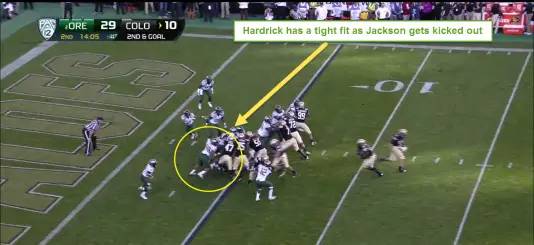 When the Colorado ball carrier follows his lead blocker, he’s crushed by Hardrick for a minimal gain.
When the Colorado ball carrier follows his lead blocker, he’s crushed by Hardrick for a minimal gain.  It’s important to note what happens when we have pulling linemen or lead backs leading up into a hole. From an offensive standpoint, lead backs create an additional gap to that side. That means someone has to insert into the defensive run fits to account for a new gap. That can either be a Linebacker from the back side (who follows the pulling guard as part of his run read), the free safety or another alley defender or the secondary force defender – as we see Ekpre-Olomu doing in this example.
It’s important to note what happens when we have pulling linemen or lead backs leading up into a hole. From an offensive standpoint, lead backs create an additional gap to that side. That means someone has to insert into the defensive run fits to account for a new gap. That can either be a Linebacker from the back side (who follows the pulling guard as part of his run read), the free safety or another alley defender or the secondary force defender – as we see Ekpre-Olomu doing in this example.
Check out another example, this time from the Tennessee game in 2013. Tennessee is a traditional, run-first SEC football team. Against the Ducks’ 3-4 Defense, they didn’t stray from that game plan (until they had to). Again we’re down near the goal line, when Tennessee runs an Inside Zone play, much like the one we looked at in the video. Oregon has packed the tackle box with 7 defenders and a man-to-man coverage to slow down the Volunteer rushing attack (below). 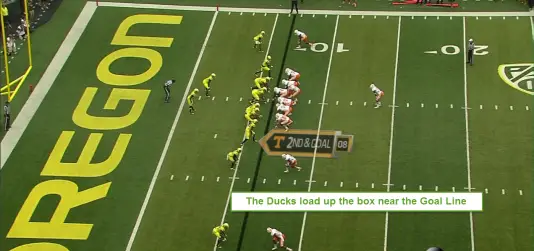 The Ducks’ Defensive Linemen, particularly No. 92 Wade Keliikipi at the Nose and No. 9 Arik Armstead at Left End, do a great job of reading the initial steps of the Tennessee Offensive Line and getting their hips in control of the inside half of the gap. The misdirection of the slot receiver looping across the backfield does freeze the Linebackers briefly, but the Defensive Linemen pay no attention to it.
The Ducks’ Defensive Linemen, particularly No. 92 Wade Keliikipi at the Nose and No. 9 Arik Armstead at Left End, do a great job of reading the initial steps of the Tennessee Offensive Line and getting their hips in control of the inside half of the gap. The misdirection of the slot receiver looping across the backfield does freeze the Linebackers briefly, but the Defensive Linemen pay no attention to it.  Keliikipi is the key player here. He posts with the right arm to control the Center, and shows that bright yellow jersey in the gap. Armstead and Inside Linebacker No. 22 Derrick Malone, also have the inside half of their gaps under control. The Volunteer running back is stopped in his tracks and forced to cut back when he sees no room for a positive gain to the left.
Keliikipi is the key player here. He posts with the right arm to control the Center, and shows that bright yellow jersey in the gap. Armstead and Inside Linebacker No. 22 Derrick Malone, also have the inside half of their gaps under control. The Volunteer running back is stopped in his tracks and forced to cut back when he sees no room for a positive gain to the left. 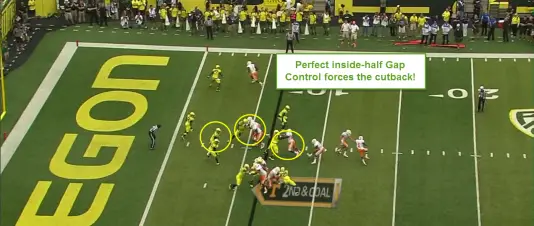 With the back side force defender, No. 91 Tony Washington, staying home to check for counters, reverses or bootlegs, there’s no open grass on the cutback, either. Washington and Keliikipi finish off the play for a short Tennessee gain.
With the back side force defender, No. 91 Tony Washington, staying home to check for counters, reverses or bootlegs, there’s no open grass on the cutback, either. Washington and Keliikipi finish off the play for a short Tennessee gain. 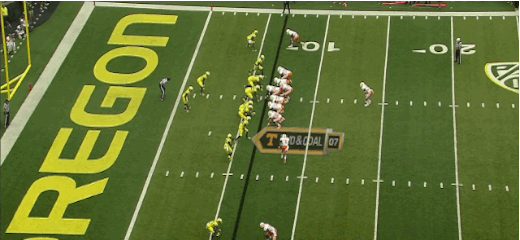 Defending the run game is a like putting together a puzzle. Everyone has to do their job, and fit into the offensive blockers. When done right, Oregon’s version of the 3-4 Defense is as stout as any in the country against the run game. Coaches have a big job of teaching every player on the defense to do their job. Spill players have to know not only what gap they are responsible for, but exactly how to defend that gap — how do they fit into the run play.
Defending the run game is a like putting together a puzzle. Everyone has to do their job, and fit into the offensive blockers. When done right, Oregon’s version of the 3-4 Defense is as stout as any in the country against the run game. Coaches have a big job of teaching every player on the defense to do their job. Spill players have to know not only what gap they are responsible for, but exactly how to defend that gap — how do they fit into the run play.
When all 11 players know their job, and execute their job, the defense will create an impenetrable wall that few teams will be able to bust through. I love watching the evolution of this Duck defense. The Oregon coaching staff has a tough job of defending the high-powered spread offenses of the Pac-12, while still being able to bow up and stuff power rushing attacks (one particular power running team comes to mind!).
This 3-4 Defense has all the tools, but it will all come down to execution if the Ducks are going to be even stronger in 2014!
Top photo from video
Joe Daniel will be entering his 13th season of coaching in 2014, with experience in both High School and College. He is currently the Defensive Coordinator and Offensive Line Coach at Prince George High School near Richmond, Virginia. Coach Daniel’s website, Football-Defense.com is one of the largest resources for defensive coaching information on the web today. You can contact Coach Daniel by email at footballdefense@gmail.com or on Twitter @footballinfo.
Joe Daniel (Football Analyst) is the author of Football-Defense.com and Football-Offense.com, and host of The Football Coaching Podcast. Coach Daniel has written over 300 articles and produced six eBooks on coaching football. With 10 years in coaching both High School and College Football, he will be the Defensive Coordinator for Prince George High School in Prince George, Virginia for the 2012 season.

